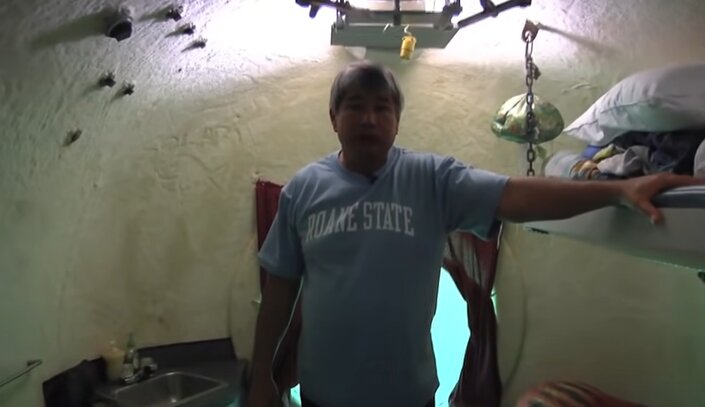
As nightmares go, being trapped in a small box deep underwater is probably high on many peoples’ lists. But one US professor is doing this on purpose. Joe Dituri, a former US navy diver and expert in biomedical engineering has been living in a 55 square meter space 30 feet below the surface of the Florida Keys since March 1, and plans to stay for 100 days. If he manages this, he will break a record for most time spent in a habitat beneath the surface of the ocean.
Dituri conducts research into the effects of hyperbaric pressure—when air pressure is greater than it would be at sea level—on the human body. He is hoping to use his time spent below the surface to examine what impact living in this high-pressure environment has on his health.
Interestingly, Dituri’s endeavor will be very different from living on a submarine. Submarines are sealed when submerged and maintained at sea level pressure. This means there’s no significant difference in pressure, even when a submarine is at depths of hundreds of meters.
But Dituri’s underwater habitat won’t have any solid hatches or air locks between the ocean and the dry living space, as a submarine does. Think of it like when a glass of water is turned upside down and pushed into a sink full of water. A pocket of air will still exist at the top of Dituri’s living space, with a pool of water in the floor of one room that comes from the ocean outside.
This means that the air inside his habitat is squeezed by the ocean’s weight, increasing the air pressure around him. At a depth of 30 feet, the air pressure inside this habitat is about twice as much as what he’d be used to on land.
Under pressure
Little research has investigated what effect long-term exposure to hyperbaric pressure has on the body.
As every certified diver is well aware, though, hyperbaric pressure can pose a very real threat to us. Our bodies have been adapted by generations of evolution for sea level conditions, where the two major gases involved in breathing (oxygen and carbon dioxide) are the only two that freely cross between our lungs and our blood.
But as pressure increases, nitrogen in the air is forced across the delicate walls of our lungs and into our blood. This can cause a range of adverse effects. At depths of ten to 30 meters, this may cause mild euphoria and positive moods. After about 30 meters below sea level and beyond, it can lead to intoxicated-like behavior—hence the name “narcosis.”
Scientists don’t fully understand why this happens, but it could be due to changes in the way neurotransmitters signal between neurons in our brain. Fortunately, this won’t be a risk to Dituri, as he’s only at a depth of ten meters.
Health changes
But Dituri can expect to experience other physical changes while living in his underwater habitat.
Although the habitat has large windows, Dituri will still only be exposed to half the amount of sunlight as on land. This could cause issues with his circadian rhythm—the internal “clock” that controls many body functions, including our sleep-wake cycle—which relies on daylight. This may mean disrupted sleeping.
Another challenge for Dituri will be getting enough vitamin D. The skin must receive UV exposure to make this vitamin, and this typically comes from the sun. It’s likely that Dituri will not be exposed to enough vitamin D while living in his underwater environment.
Vitamin D plays key roles in maintaining bone density, muscle function and immunity. Research on people who lived at an underwater habitat run by NASA as a spaceflight analogue found they had reduced immune function after only a 14-day stay.
Dituri will need to get vitamin D from other sources—such as foods high in vitamin D, supplements or from UV lamps—to minimize reductions in his immune function. Even though Dituri will be living alone, astronauts living in similar environments report latent infections occuring. These are viruses that many of us carry which our immune system normally keeps under control. This could also cause Dituri to fall ill if his immune function wavers.
Besides a minimal amount of walking around a very small habitat, the only exercise Dituri will get is from swimming. As swimming is non-weight bearing, losses in bone and muscle mass are likely—and may be similar to what astronauts see during long missions on the International Space Station (but not as extreme). Adding some resistance exercises such as squats and lunges may help Dituri offset muscle and bone mass losses.
Long-term effects
While Dituri’s underwater habitat will be different from a submarine, the amount of time he’s spending there is not altogether different from what many submarine crews endure. We know from research on submariners that even just a few months below the surface can have long-term effects, despite measures to prevent this from happening.
For instance, even after two months below the sea, submariners still had disturbed sleep patterns and problems with the levels of certain hormones linked to sleep. Crew also showed losses in bone and muscle mass. This reinforces how important it will be for Dituri to get enough vitamin D exposure and exercise.
Of course, the biggest question that remains is what effect long-term hyperbaric pressure will have on Dituri. What studies we do have on the effects of hyperbaric pressure have only looked at short-term exposures, which may have shown positive effects on wound healing. This will be both a physiologically and possibly psychologically challenging feat so, although Dituri is only one person, data from his experiment will still be useful to the field.
Provided by
The Conversation
This article is republished from The Conversation under a Creative Commons license. Read the original article.
Source: Read Full Article
